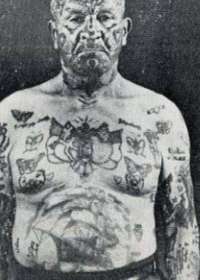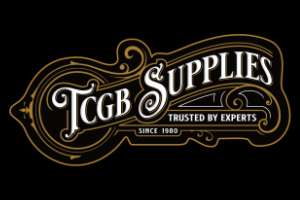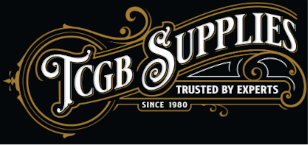Back to Top
May 22, 2009
100074

Tattoo's make the news in South Africa
On the 26th of December 1961 ‘The Johannesburg Star’ newspaper of South Africa reported on the story of Jacobus Van-Dyn.
Van-Dyn was in London trying to sell his tattooed head, Van-Dyn told the paper that his head would be hacked off upon his death and then given to whoever bought it. Of course it never happened and when Jacobus passed away in the early 1980’s his head went with him to the grave.
Mr Jacobus Van-Dyn - Little is known about his personal life except that he was a South African born in 1896, but what we do know about old Van Dyn was that he styled himself - as a devil may care sort of gangster like character who wasn’t afraid to tell anyone who wanted to listen about his adventurous life.
Something he would do on any given Sunday at Speakers Corner, Hyde Park, London – where he would tell all - about his life – with the same speech each week – what went as follows ‘Ladies and gentlemen; in case you don’t know who I am – I’m the man who was over there a second ago’ this he would say after he had got off his soapbox and kicked it across the ground loudly to draw attention to himself – which nine times out of ten worked perfectly in drawing the people especially with his stentorian ways - before going on to tell of his time spent in some of the worlds worst prisons including San Quentin, Bonamora, Sing Sing, Dartmoor and in Central Prison, Pretoria.
He would also tell one of his favourite jokes ‘I was once at Oxford College and that’s the truth – I was only there a minute and a half before the burglar alarm went off and I had to get the hell out of there’ He also claimed to have helped to get Woodrow Wilson into the White House by voting for him fifteen times in one day – where for doing this – Jacobus told his audience that the new (28th) President Of America sent him 50 dollars in gratitude; (now for histories sake – Jacobus would tell his listeners that Wilson became President after William Taft died (Taft was 27th President) – But of course we all know that Taft later went on to become the Chief Justice of the supreme court from 1921 to 1930 and that he outlived Wilson by some six years – Wilson dying in 1924 after having a stroke of which he never really recovered in 1919 – Taft passed away in 1930.
Jacobus would also shout out in Hyde Park that he had three brothers with one being a Judge in America and the other two being lawyers – that he was once the sparring partner of boxing champion Jack Dempsey and he was also the American public enemy number six (not 1 but 6) – we do know that Jacobus was at one time a very good wrestler calling himself the masked marvel - wrestling at bouts at Manor Baths, in London and other various halls throughout the city.
Other entertaining tales came in the form of rants about the British police fitting him up on a charge that got him a seven year prison term - all because he was once a notorious gun runner for Chicago’s famed bootlegger Al Capone. There was some truth in the statement – but his incarceration had nothing to do with big Al - as he was sentenced to seven years hard labour in England and sent to Dartmoor prison in June 1931 for the armed robbery of 21-year-old Robert Devin of Ruislip, Middlesex.
And even though he had the alibi of being with two young ladies Phyllis Windle and Ethel Strachan at Tower Bridge when the robbery was supposed to have taken place - the recorder of London Sir Ernest Wild ignored this and told Van Dyn; ‘you have aggravated your offence by bring forward an absolutely false alibi – Lucky for you that you are not charged with murder – In that case you would undoubtedly have hanged – you will go to prison for seven years.
Even the British tabloids had a field day with this and in a press report about the trial in the ‘News Of The World’ newspaper a reporter wrote: seven years? The sentence fell with stunning emphasis upon a hushed court’ – as even he (a hardened newsroom hack) couldn’t believe the harsh punishment handed down to Van Dyn. Of course Van Dyn petitioned the secretary of state and appealed (criminal appeal act of 1907) the judgment by reiterating his alibi and luckily for him the Home Office investigated the case and came to the conclusion that he was indeed innocent of the crime and released him some six months later.
Home Secretary Sir Herbert Samuel released a statement as follows ‘Searching investigation was made by the police and my advisers, and, as a result additional information was brought to light. After consultation with the learned Recorder before whom he was convicted, I felt justified in all the circumstances in recommending the absolute remission of his sentence of seven years penal servitude’ - Questions about the case and treatment of Van Dyn were even asked about in the House Of Commons – and upon his release from Dartmoor, the prisons governor S.H. Roberts wrote that Jacobus Peters Van Dyn’s (F.177) conduct under sentence was good.
He was released under rule 23 of the British justice system – which doesn’t allow the appeal court to consider if the said person was guilty or not – so the conviction was left on record – and with the crime being left on record it didn’t allow for any entitlements to any compensation - Compensation if anything came in the form of his speaking at Hyde Park about this for the next 30 years or so.
And it was because of his time in prison (of which Jacobus always said was because of mistake and identity) that prompted his decision in getting his face tattooed (so no one would ever be able to accuse him of any crime ever again) – We know his face was tattoo free when he left gaol – as a ‘News Of The World’ newspaper report after his release – said of him as ‘being powerfully built, with black hair and bald patch on his crown, a wide mouth, perfect teeth, brown eyes and a flat nose.
In fact Jacobus couldn’t really have complained much about his wrongful? arrest and jail time – for if he didn’t do that he certainly did other misdemeanours which started in 1909 when he was sent to reform school for theft until he was 16 – again in 1909 when he got three years for common assault and sent to ‘Breakwater Institution in Cape Town. 1914 saw him sentenced to three years hard labour for breaking into various premises – 1920 fourteen days for disorderly conduct in Liverpool, England – 1921 four months for stealing - also in Liverpool – 1927 three months hard labour for being a suspected person? In London - 1928 nine months hard labour in London – again for being a suspected person and in 1929 eighteen months hard labour with fifteen strokes of the cat for robbery while armed – Of course this is all on record and much of these times he spent in British prisons coincided with Al Capone’s era in the United States – Jacobus also reckoned he was the great friend of Dion O’Bannion a rival bootlegger to Capone – and although no charges were brought against Al Capone when O’Bannion was shot dead in his flower shop on the 4th of November 1924 – this act prompted a retaliatory attack on the Chicago crime lord – it failed of course – so it is debatable whether someone close to Al Capone would have been allowed to befriend a rival and enemy – although some do (did) believe that Jacobus was at some stage in America – where he worked as a kitchen porter at Johnny Farmers kip house on the ‘Seven dials’.
The next time anything was heard of Van Dyn was when he turned up at Burchett’s and stated to have his face tattooed with flowers, butterflies and a love heart on his nose - that sat easily with his two tattooed moustaches - which had two points pointing up and two points pointing down and a large dragon that warped around the back of his skull that he said was there to keep him nice and cosy, a crucifix on his back and various tattoos all over his torso – George Burchett tattooed Van Dyn and he paid £100 pounds for them (the same as the Omi before him paid) - He also had flyers made which described him as the ‘Worst Man In The World’ and was also seen from time to time at Tower Hill, London - doing an escapologist act before heading off to the park to spin his tales – as well as selling cough mixtures, pills (of which he made himself) and horseshoes to the unsuspecting public to make ends meet.
As far as anybody knows Jacobus Van Dyn never married or had children and he had lived at Rowton House in Vauxhall, London since 1927 – which was a doss-house for down and outs – He always worked though and for a number of years he was employed at ‘Mahoney’s Timber Yard’ in Walworth Road, London – It also has to be said that he could well have done all the things he said he had done but it is highly unlikely – but what a character – he also made the newspapers in England on many occasions – with the story of him selling his head to anyone who cared to have it after his death – And tattoo artist’s Ben Gunn, Tattoo Jock, Cash Cooper and Jack Ringo all appeared in newspaper stories – telling of them buying Jacobus head – which they would receive after his passing – All of which was great publicity for them all – Ron Ackers once recalled the time when Jacobus visited his and Micky Bloors Battersea shop to tell them that he was going to start a car cleaning business but he had no money – so if Ron and Micky could give five pounds he could buy some wax and a bucket and be on his way to a fortune – and for doing this he would get the boys some good publicity for their studio – and low and behold a short while later a newspaper reporter form the ‘South London Press’ turned up to do a story about them buying the head of Jacobus Van Dyn for the sum of five pounds.
The last time anything was ever heard of him was that he was seen working in Southampton docks in and around 1971 – and that he passed away in the early 1980’s – He was known as ‘Tattoos’ to his friends.
Copyright. Paul Sayce.
Posted 22nd May 2009


